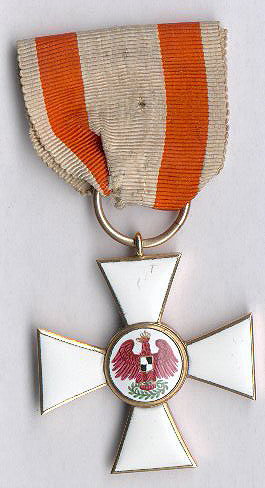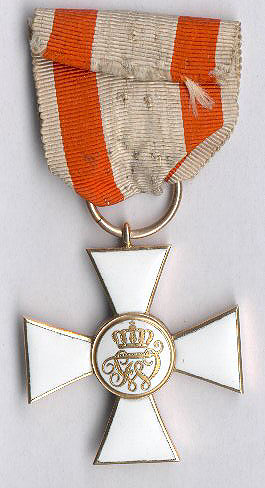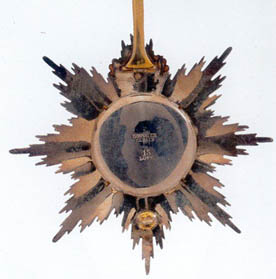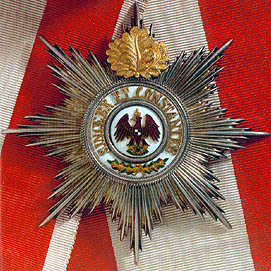During more than 200 years of
Prussian medals and orders history many different pieces
and models were made. One of the most outstanding orders
jeweler was Johann George Hossauer (October 5, 1794 to
January 14, 1874).
|

Red Eagle Order 3rd class 1829-1846
marked: "Hossauer" on the lower
cross arm
avers
|
After being educated as a
plumber, Hossauer went to Paris in 1815 to become a
gold smith. While in Paris he became a supervisor in
the manufacturing area of a gold smith company. In
1819 he left Paris and moved to Berlin to open a
plant for making goods of platinum, gold, silver,
bronze and gilt and silvered cooper in English style.
Hossauer was awarded a golden medal for an
industrial exhibition of his work in 1822. He was
also awarded the title Goldsmith of his Kings
Majesty by Wilhelm III. in 1826. In 1827
Hossauer was awarded the cross 4th class of the Red
Eagle Order and 1839 the 3rd class with bow for
developing burn rockets for infantry rifles. In 1841
the technique of electrolytic gilding substituted
for the old poisonous fire gilding. In 1844 Hossauer
employed 63 workers in his firm and 34 additional
worker outside his site. His firm and storage was
situated at Kronenstreet 28. After finishing the
"shield of belief" for the older son of Queen
Victoria of England, Hossauer was awarded the Great
Golden Medal for a
Arts and Science of the Prince of Wales.
In 1858 he became Kommerzienrat, in 1859 when
he retired he was awarded the title Senior
Goldsmith of his Kings Majesty (Friedrich
Wilhelm IV.), and in 1863 he became Geheimer
Kommerzienrat. He also was awarded the knights
cross of the House Order of Hohenzollern. In 1867 he
was awarded the 2nd class of the Order of the Crown. |
|

reverse
|
The importance and
contributions of J.G. Hossauer to the design,
development and making of orders and medals, not
only in Prussia, was tremendous. After 1840 he
developed, with the collaboration of King Friedrich
Wilhelm IV, the collar chains for the Black Eagle
Order. The last change of the design of the order
Pour le Mérite is connected to him. The development
of full metal breast stars, equal in their fragile
and delicate construction to the tinsel stars made by
Fehrmann, were made in his firm. The basic
design for the House Order of Hohenzollern was also
made by Hossauer. Probably the design for the Order
of the Crown was made by him, at least the technical
manufacturing, since he remained the Kings
Advising Goldsmith after he retired in 1859. The
grand cross decorations for the order Pour le Mérite
in 1866 and the design of the War Merit Medal 1870
were based on Hossauer layouts.
Hossauer was the goldsmith
chosen when an important work or design had to be
created or made. His designs not only highlighted
the art of the 19th century, but also its culture.
He was like Humbert & Son the court jeweler in
Prussia. Regarding his talent and name, he wrote his
invoices. Other jeweler went below his prices, as
pictured in letters connected to the issue of the
House Order of Hohenzollern. |
Therefore the King's Prussian
Order Commission ordered only a limited number of
decoration from the Hossauer firm, since they had fixed
purchasing prices. This must be a reason, that the high
quality Hossauer made decorations are extremely rare.
Often only the private ordered decorations, made
specially for wealthy people, can be found. Because the
order didn't have to be returned.
Hossauer made decorations are
marked as follows:
crosses: HOSSAUER

breast stars: HOSSAUER/BERLIN/15/LÖTH
|

Reverse of a star 1st
class |

Avers |
© A. Schulze Ising, IX/99
|





